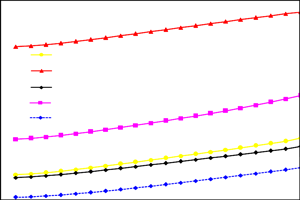Performance of novel versions of CFAR detection schemes processing M-correlated sweeps in presence of interferers
DOI:
https://doi.org/10.3103/S0735272719040010Keywords:
MTI, CFAR processor, moving target indicator, clutter and interference, derived detector, incoherent integration of M pulses, multiple-target situationsAbstract
The detection of moving target (MTI) against clutter background represents one of the most important goals of a radar system. To achieve this objective, it is necessary to suppress or cancel the clutter returns with as small suppression of the target signal as possible. In this regard, MTI radar is capable of detecting such type of targets in the presence of interferers. Radar MTI is of great interest in civil and military applications, where it reduces the returns from stationary or slowly moving clutter. Additionally, in order to make decisions on the target presence, the MTI processing may be applied with automatic detection. In this situation, the CFAR detection is a common style of adaptive algorithms employed in radar systems to detect target returns against a background of noise, clutter and interference. However, the presence of MTI complicates the analysis of the detection system performance since its output sequence is correlated even though its input sequence may be uncorrelated. Our goal in this paper is to analyze the performance of a radar signal processor that consists of a nonrecursive MTI followed by a square-law integrator and a new version of CFAR circuit detection; the operation of which is based on the hybrid combination of CA and TM algorithms. The processor performance is evaluated for the case where the background environment is assumed to be ideal (homogeneous) as well as in the presence of spurious target returns amongst the contents of the reference cells. The numerical results exhibit that the processor performance can be enhanced through either increasing the number of incoherently integrated pulses or decreasing the correlation among consecutive sweeps, given that the rate of false alarm is keeping constant.References
- DILLARD, G.M.; Rickard, J.T. “Performance of an MTI followed by incoherent integration for nonfluctuating signals,” Proc. of IEEE Int. Radar Conf., 28-30 Apr. 1980, San Diego, USA. IEEE, 1980, p.194-199.
- EL MASHADE, M.B. “Performance analysis of the OS family of CFAR schemes with incoherent integration of M-pulses in the presence of interferers,” IEE Proc. Radar, Sonar Navig., v.145, n.3, p.181, June 1998. DOI: https://doi.org/10.1049/ip-rsn:19981607.
- MACHADO-FERNANDEZ, Jose Raul; MOJENA-HERNANDEZ, Norelys; BACALLAO-VIDAL, J.C. “Evaluation of CFAR detectors performance,” Iteckne, v.14, n.2, p.170, 2017. DOI: http://dx.doi.org/10.15332/iteckne.v14i2.1772.
- EL MASHADE, M.B. “M-correlated sweeps performance analysis of mean-level CFAR processors in multiple target environments,” IEEE Trans. Aerospace Electronic Systems, v.38, n.2, p.354, Apr. 2002. DOI: https://doi.org/10.1109/TAES.2002.1008971.
- ISLAM, Md. Maynul; HOSSAM-E-HAIDER, Mohammed. “Detection capability and CFAR loss under fluctuating targets of different Swerling model for various gamma parameters in RADAR,” Int. J. Advanced Computer Sci. Applications, v.9, n.2, p.90, 2018. DOI: http://dx.doi.org/10.14569/IJACSA.2018.090214.
- EL MASHADE, M.B. “M-correlated sweeps performance analysis of adaptive detection of radar targets in interference-saturated environments,” Ann. Telecommun., v.66, n.11-12, p.617, 2011. DOI: https://doi.org/10.1007/s12243-010-0236-5.
- WANG, W.Q. Radar Systems: Technology, Principles and Applications. Nova Science Publishers, Inc, 2013.
- YADAV, Ajay Kumar; KANT, Laxmi. “Moving target detection using VI-CFAR algorithm on MATLAB platform,” Int. J. Advanced Research Computer Science and Software Engineering, v.3, n.12, p.915, Dec. 2013.
- KIM, Chang J. “A new formula to predict the exact detection probability of a generalized order statistics CFAR detector for a correlated Rayleigh target,” ETRI J., v.16, n.2, p.15, 1994. DOI: https://doi.org/10.4218/etrij.94.0194.0022.
- IVKOVIĆ, Dejan; ANDRIĆ, Milenko; ZRNIĆ, Bojan. “A new model of CFAR detector,” Frequenz, v.68, n.3-4, p.125, Mar. 2014. DOI: http://dx.doi.org/10.1515/freq-2013-0087.
- MANDAL, Amritakar; MISHRA, Rajesh; “An adaptive clutter suppression technique for moving target detector in pulse Doppler radar,” Radioengineering, v.23, n.1, p.84, Apr. 2014. URI: https://www.radioeng.cz/fulltexts/2014/14_01_0084_0095.pdf.
- QIN, Yuhua; GONG, Huili; LIU, Ting. “A new CFAR detector based on automatic censoring cell averaging and cell averaging,” TELKOMNIKA, v.11, n.6, p.3298, 2013. DOI: https://doi.org/10.11591/telkomnika.v11i6.2686.
- SHOME, Subhankar; BERA, Rabindra Nath; SUR, Samarendra Nath; ADHIKARY, Rabi. “Moving target detection and Doppler extraction using digital spread spectrum radar,” Int. J. Intelligent Systems Applications, v.6, n.10, p.47, 2014. DOI: http://doi.org/10.5815/ijisa.2014.10.07.
- EL MASHADE, M.B. “Heterogeneous performance evaluation of sophisticated versions of CFAR detection schemes,” Radioelectron. Commun. Syst., v.59, n.12, p.536-551, 2016. DOI: https://doi.org/10.3103/S0735272716120025.
- EL MASHADE, M.B. “Heterogeneous performance analysis of the new model of CFAR detectors for partially-correlated χ2-targets,” J. Systems Engineering Electronics, v.29, n.1, p.1, Feb. 2018. DOI: https://doi.org/10.21629/JSEE.2018.01.01.

Downloads
Published
2019-05-11
Issue
Section
Research Articles

